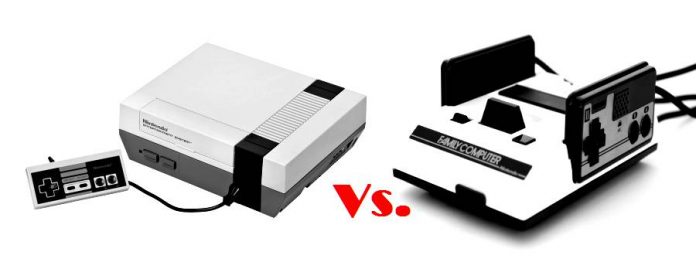
Nintendo made the 2016 holiday season a great one with the release of the NES Classic Edition and the Famicom Mini, two of the first widely successful consoles by the Japanese video game giant.
While the NES Classic Edition launched exclusively in North America and Europe, the Famicom Mini saw the light of day only in Japan and Australia as part of an extremely limited release.
Nostalgia-driven players and retro gaming collectors rejoiced at the news, and upon release in November the consoles quickly sold out. The few ones left are hard to find, but you should know the advantages of each if you want to get any of them.
The NES mini is more practical than the Famicom
In terms of design, the console of your choice is largely a personal matter. Most gamers played on a Nintendo Entertainment System, but the original Famicom may be more visually appealing to people nowadays.
The black and gray box that was the NES is not as aesthetically pleasing as the red and beige Famicom, which nowadays looks even more retro than before with a glossy finish.
Both Nintendo consoles are simply small versions of the originals, and both come with the same core issue the first NES and Famicom had: Their controllers.
Players have reported the controllers on the NES Classic Edition not only are too small, but their cords are too short. This problem is ever worse on the Famicom since it honors its legacy design with built-in gamepads that cannot detach from the console more than a couple of meters.
The NES Classic Edition and the Famicom Mini have the same internal specs
Regarding game performance, both Nintendo consoles offer pretty much the same experience since they pack the same emulation system and display modes.
Gamers can choose to play games on the traditional 4:3 NES and Famicom aspect ratio, or as they were originally designed with the Pixel Perfect mode. A third display option with a CRT filter is available.
When it comes to playing, though, the short cord and control size issue on both consoles makes them a little uncomfortable to play, especially for players with extra-large hands.
The NES comes out on top here thanks to its detachable controllers, which allow support for third-party gadgets that provide wireless solutions via Bluetooth. This is impossible to do on the Famicom Mini.
What about the games?
The Famicom Mini and the NES Classic Edition both come preloaded with 30 games, 22 of which the two consoles share.
Among the titles included in both consoles are Super Mario Bros. 1, 2, and 3, Metroid, The Legend of Zelda, Kirby’s Adventure, Pac-Man, Mega-Man 2, Castlevania, Donkey Kong, Ninja Gaiden, and more.
The NES Classic Edition exclusives are Bubble Bobble, Castlevania II: Simon’s Quest, Donkey Kong Jr., Final Fantasy, Kid Icarus, Punch-Out!, StarTropics, and Tecmo Bowl.
The Japanese Famicom Mini comes with mostly local titles, but it does include notable games like Final Fantasy III, NES Open Tournament Golf, Solomon’s Key, and Yie Ar Kung Fu.
The decision here is also a matter of taste, but it is important to note that even though the interface of both consoles support up to eight languages, the games on the Famicom Mini are solely playable in Japanese.
Both the NES Classic Edition and the Famicom Mini sold for $59.99 or its equivalent in the local currency on markets where they are available.
Source: Nintendo










